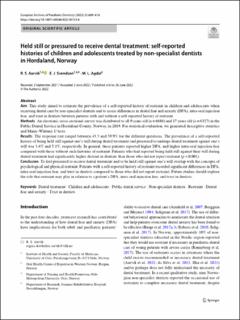| dc.contributor.author | Aarvik, Regina Skavhellen | |
| dc.contributor.author | Svendsen, Edel Jannecke | |
| dc.contributor.author | Agdal, Maren Gry Lillehaug | |
| dc.date.accessioned | 2023-02-20T14:18:02Z | |
| dc.date.available | 2023-02-20T14:18:02Z | |
| dc.date.created | 2022-09-13T09:23:34Z | |
| dc.date.issued | 2022-06-28 | |
| dc.identifier.citation | European Archives of Paediatric Dentistry. 2022, 23 (4), 609-618. | en_US |
| dc.identifier.issn | 1818-6300 | |
| dc.identifier.issn | 1996-9805 | |
| dc.identifier.uri | https://hdl.handle.net/11250/3052439 | |
| dc.description.abstract | Aim: This study aimed to estimate the prevalence of a self-reported history of restraint in children and adolescents when receiving dental care by non-specialist dentists and to assess differences in dental fear and anxiety (DFA), intra-oral injection fear, and trust in dentists between patients with and without a self-reported history of restraint.
Methods: An electronic cross-sectional survey was distributed to all 9 years old (n = 6686) and 17 years old (n = 6327) in the Public Dental Service in Hordaland County, Norway, in 2019. For statistical evaluation, we generated descriptive statistics and Mann–Whitney U tests.
Results: The response rate ranged between 43.5 and 59.9% for the different questions. The prevalence of a self-reported history of being held still against one’s will during dental treatment and pressured to undergo dental treatment against one’s will was 3.6% and 5.1%, respectively. In general, these patients reported higher DFA, and higher intra-oral injection fear compared with those without such histories of restraint. Patients who had reported being held still against their will during dental treatment had significantly higher distrust in dentists than those who did not report restraint (p < 0.001).
Conclusion: To feel pressured to receive dental treatment and to be held still against one’s will overlap with the concepts of psychological and physical restraint. Patients with a self-reported history of restraint recorded significant differences in DFA, intra-oral injection fear, and trust in dentists compared to those who did not report restraint. Future studies should explore the role that restraint may play in relation to a patient’s DFA, intra-oral injection fear, and trust in dentists. | en_US |
| dc.language.iso | eng | en_US |
| dc.publisher | Springer | en_US |
| dc.relation.ispartofseries | European Archives of Paediatric Dentistry;Volume 23, issue 4 | |
| dc.rights | Navngivelse 4.0 Internasjonal | * |
| dc.rights.uri | http://creativecommons.org/licenses/by/4.0/deed.no | * |
| dc.title | Held still or pressured to receive dental treatment: self-reported histories of children and adolescents treated by non-specialist dentists in Hordaland, Norway | en_US |
| dc.type | Peer reviewed | en_US |
| dc.type | Journal article | en_US |
| dc.description.version | publishedVersion | en_US |
| dc.rights.holder | © The Author(s) 2022 | en_US |
| cristin.ispublished | true | |
| cristin.fulltext | original | |
| cristin.qualitycode | 1 | |
| dc.identifier.doi | https://doi.org/10.1007/s40368-022-00724-8 | |
| dc.identifier.cristin | 2051053 | |
| dc.source.journal | European Archives of Paediatric Dentistry | en_US |
| dc.source.volume | 23 | en_US |
| dc.source.issue | 4 | en_US |
| dc.source.pagenumber | 609-618 | en_US |

